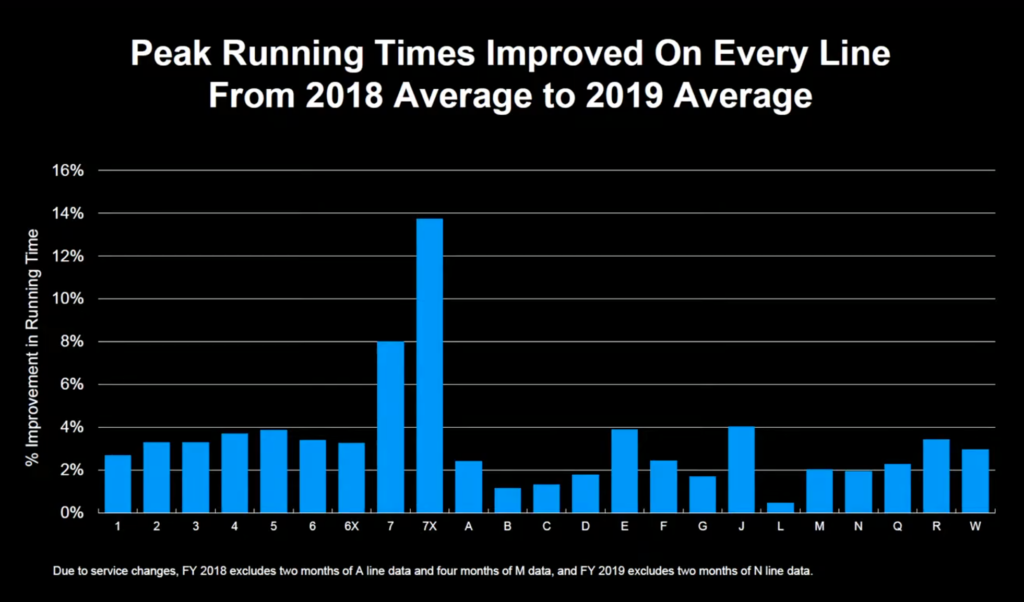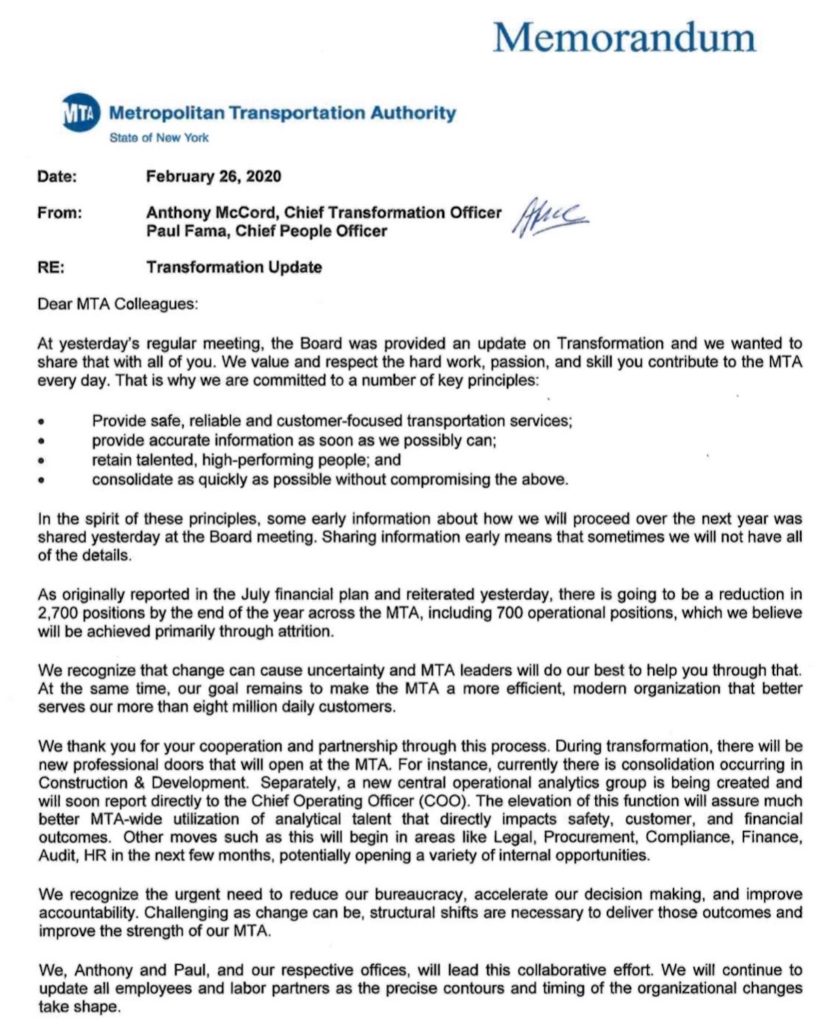
During the first MTA Board meeting of the post-Andy Byford Era, Sally Librera, the senior vice president of subways, shared some positive news about subway speeds. As the chart shows, subway run times have decreased, year-over-year, on every subway line, and in turn, train speeds are getting faster.
“Peak run times on nearly every line are continuing to improve,” Librera told the Board’s Transit Committee. “Every single line in the system got faster, which is an incredibly encouraging result.” Librera credited a number of initiatives, including the CBTC-based bump in 7 train performance, but in focusing on the A Division — the numbered lines — which showed the most improvement, she praised Transit’s SPEED Unit. These improvements, she noted, “track with the number of civil speed changes.”
In a way, the SPEED Unit was Andy Byford’s crowning achievement and, according to most reports and my own sources, the straw that broke the governor’s back, and the chart Librera presented to a Byford-less room on Monday was a testament to what was and what could have been. Andy Byford arrived in New York amidst a crisis; he listened to a lot of people ask a lot of smart questions concerning slow trains that had gotten slower in recent years, faulty signal timers that were miscalibrated and speed restrictions that were unnecessary. He established a team that carefully and systematically studied signals throughout the subway system and fixed them so that trains could run faster and operators could have faith that they wouldn’t trip a red by going the posted speed. He worked with the union to reduce the onerous penalties train operators would incur by tripping those fault signals, and he produced a subway system that is saving millions of New Yorkers hours per year in unnecessarily slow trips.
What did this effort earn him? Scorn from Albany and a one-way ticket out of the job atop Transit. The signals effort wasn’t the only point of conflict between Gov. Cuomo and his hand-picked Transit president, but as I explored last month in the aftermath of Byford’s departure, it was front and center amidst the conflict. As Byford’s SPEED Unit picked up steam, Cuomo wanted something more — faster returns or more credit.
While Byford was focused on doing the job slowly and carefully while maintaining safety, Cuomo wanting everything faster, faster, faster. It was the same approach he took to completing the Second Ave. Subway, a decision that cost the MTA millions and arguably led to the 2017 declines in subway performance. The governor commissioned his own signals report, which was released at around 5 p.m. on New Years Eve and became a political football in the dispute between the two men. Byford claimed it reinforced the Save Safe Seconds campaign while Cuomo and his allies pushed for a more aggressive approach to speeding up trains, improving dispatching practices and reducing dwell times. It wasn’t quite a bombshell, but it exacerbated already-high tensions between Byford and Cuomo.
As the MTA’s transformation plan picked up steam, Byford and his team were essentially sidelined from the signals process, and that was one area where Byford felt he was in the right and knew he was making the right difference. The governor knew that too as Byford had routinely communicated he desire to remain in charge of signals to the Chamber, but when push came to shove, this was not arrangement Albany wanted to support.
Will Sally Librera’s slide — one last victory lap for the beloved Train Daddy — be the MTA’s high-water mark on improving speeds and fixing fault signals? I hope not, but as with much within the MTA these days, we can’t be sure. In the week since Byford has left, the conversation has shifted from fixing things to eliminating things, a move Cuomo apparently had hoped Byford would implement two years ago. But when Byford dug into the bones of the MTA, he found a staff that needed guidance rather than elimination.

Now, though, jobs are on the line, as you can see from this letter Chief Transformation Officer Anthony McCord (the not-a-hatchet-man hatchet man) sent out late on Thursday afternoon. The MTA will soon be radically overhauled, but in a way that doesn’t make sense or attack the agency’s root causes. While some back-office rationalization is necessary, morale within the agency is at a low as workers fear for their jobs, and a bunch of hand-picked Cuomo appointees have come to cut an agency that needs anything but cuts these days. We’ve turned a swift corner, and I don’t like where things are heading. But for now, we’ll have those faster trains, a testament to what can happen when someone with a true vision, dedication and belief in his job is allowed to make positive change. Better things are possible.

4 comments
It will be interesting to see if interim NYC Transit Authority President Ms. Sarah Feinberg and her permanent successor will be successful in preserving both funding and implementation of projects and programs championed by Andy Byford’s Fast Forward: The Plan to Modernize NYC Transit subway and bus system. Let’s hope that $19 billion worth of funding support in the current $51 billion MTA 2020 – 2024 Five Year Capital Plan remains in place. We will have to wait and see if the $19 billion balance of funding needed to complete this plan will be approved in the next MTA 2025 – 2029 Five Year Capital Plan. There will be some clues of what the future holds when the MTA releases the updated MTA 2020 – 2040 Twenty Year Long Range Capital Needs Plan. It was suppose to be released in December 2019. Why has the MTA delayed release for two months? Are they waiting for it to be approved by Governor Cuomo before making it public?
Larry Penner — Transportation Advocate.Historian and Writer who previously worked 31 years for the Federal Transit Administration Region 2 NY Office. This included the review, approval and oversight for billions of dollars in grants to the MTA which funded NYC Transit capital projects and programs) .
I do think it is fair to say that the push for autonomous vehicles has raised the bar for what should be possible in railroad signaling. The inability to navigate the complicated environment of multi-use streets has meant that companies such as Waymo have yet to achieve any revenues from their investment. Perhaps some or all of them could be induced to step into the simpler railroad signaling world, along with perhaps Jack Dorsey, founder of Twitter and Square, who was fascinated by railroad signaling as a teenager.
CBTC does two things. It replaces the signals with electronic instructions that allow a more accurate measure of the location of other trains. And it automates the control of the trains based on those instructions. Given that old time signals will be in place on the system for decades, it might make sense to separate those two things.
First, the autonomous vehicle technology could be used to control the trains. It would operate the trains based on viewing existing signals and signs — and perhaps scanning for people on the tracks. This would be much easier than what the AV companies are trying to do now. No pedestrians, no bicycles, no cross traffic, no parallel parking, etc. etc. etc. Stopping, starting, obeying the speed limits and signals, which are in a limited number of locations relative to the front of the train.
Second, alternative radio-based moving block signaling could be installed, and become the primary information used to control the trains. But the existing signals could remain as a temporary fail-safe fallback. Basically, if CBTC told the train to go through an existing red, the AV system would override and stop it. The accuracy of the radio-based system could be evaluated while in use thanks to that fail-safe, and then the older signals could be gradually covered and then removed, with safety checked at each stage, to take full advantage of CBTC.
This could allow a much faster implementation of an entirely new system, even as the existing signals remain the primary means of control on lines where they have been installed recently, and need to be fully amortized.
With regard to administrative consolidation, the main fear has to be that the goal is to cover up and obfuscate additional transfers from city services to the LIRR.
One of the more disappointing things is not to permit a highly-qualified professional to do one’s job and after said professional has demonstrated success. The NYCT troops must be completely demoralized after having such a competent and supportive head be run out of town. Many riders must also be demoralized.